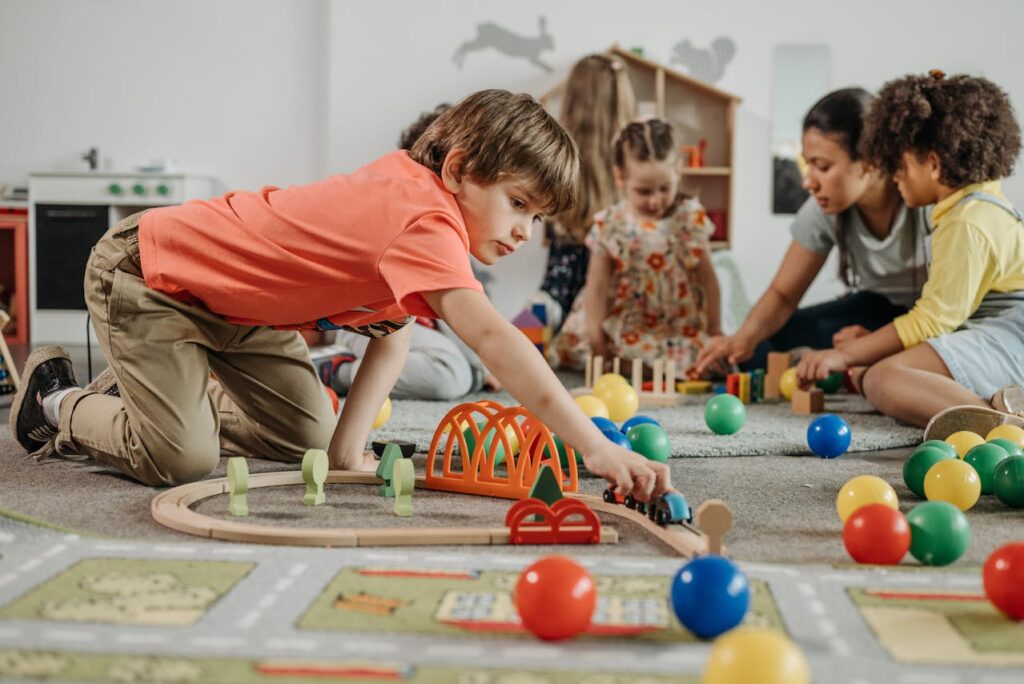Can you remember the first time you made your baby laugh? I do! Guess how? It was through a game of peekaboo! Did you know you can start playing peek-a-boo as early as 3 to 6 months of age? Playing peekaboo with your baby is not just a fun way to pass the time, it will build social skills, stimulate language development, and create a strong bond between you and your little one. All of which play an important role in a baby’s development.
The classic game of peekaboo has been played with babies for generations. This simple game has enticed babies of all ages by covering your face and then revealing silly faces. But it is more than just a silly game, the benefits of playing the peek a boo game with babies are vast and impressive.
Here I will explore why playing this game with infants is important and how to play peek-a-boo effectively.

When do babies play Peek a Boo?
Developmental psychologist Jean Piaget theorizes that a very young baby (less than 4 months of age) has no concept of object permanence. Object permanence speaks to the child’s ability to know that objects exist even when they can no longer see them. So when we “disappear” in a game of peekaboo or hide a stuffed toy underneath a blanket infants under 4 months will believe that you have vanished. During his experiment, he would hide a stuffed toy under a blanket to see if the child would get upset at its disappearance or go in search of the toy. Those who went in search of the toy were determined to have reached the developmental milestone this typically happens around months 8 to 9.
On the other hand, the understanding of object permanence when the baby gets older can be unpleasant at times. Like those moments when you have to go to work and leave your baby, this can cause separation anxiety, because your little one knows you still exist even though you aren’t visible to them so this will make them upset. The good news is this generally doesn’t last long. And for most kids, this separation anxiety will disappear by the age of 3.
Why should we play peek a boo with babies?
Social Development
Playing peek-a-boo helps infants develop important social skills, such as turn-taking and joint attention. When you cover your face and then reveal it, your little one learns to anticipate and respond to your actions. This back-and-forth interaction is crucial for visual tracking and keeping the baby’s attention. In addition, you can tie in words to get a start on language development. Naming the hidden toy and saying phrases like “Here I am” “Here is the dog” “Mommy is here”
Cognitive Development
Peek-a-boo also helps babies develop their cognitive skills. When you hide your face, your baby must remember that you still exist even though they cannot see you. This helps infants understand the concept of object permanence – the idea that objects continue to exist even when they are out of sight.
Emotional Development
Playing peek-a-boo with babies can also help them regulate their emotions. The surprise of seeing a familiar face reappear can elicit a big smile and a baby laugh helping them learn to manage their emotions and reactions in a safe and supportive environment.
Bonding
Perhaps the most important benefit of playing peek-a-boo with babies is the bonding that occurs between parent and child. This great game exercises the “serve and return” interaction. The back-and-forth repetitive game establishes the wiring of brain neurons letting your little one know you are present and reliable. Creating a strong bond and you will now be your child’s play partner.
How to Play Peek a Boo with Babies
– Playing peek-a-boo with babies is easy and can be done in a variety of ways. Here are a few tips for playing peek-a-boo effectively with your baby:
– For very young infants, start slowly by simply covering your face with your hands or a blanket and then revealing it. Keep in mind to meet your baby at eye level and place your face a few inches away from his/her face. As your baby gets older and more familiar with the game, you can add in more facial expressions and elaborate hiding techniques, such as hiding behind objects.
– Maintaining eye contact establishes social interaction alongside a smiling face.
– You can make peek a boo more engaging by using different objects to hide behind, such as a blanket, pillow, or stuffed toy. This adds an element of surprise and novelty to the game, keeping your baby interested and engaged. You can also play the game in different ways by incorporating his/her favorite toy hiding it underneath a blanket and letting them find it. This helps to foster object recognition and the concept of object permanence.
– You can also play peek a boo by using sound in addition to sight. Making silly noises or saying “boo” when you reveal your face adds another layer of fun to the game.
– As your baby gets older, encourage them to participate in the game by hiding their face or object and then revealing it. This can help them develop their understanding of object permanence and social skills.
– Pay attention to your baby’s face, cues, and reactions during the game. If they seem tired or overwhelmed, take a break and try again later. If they are enjoying themselves, continue interacting with them positively and responsively.
– In older children, you can include more funny faces. Sooner than later the simple game evolves into a game of hide and seek.
– In a child’s development, repetition is the key to learning. So repeat as many times as you want while maintaining your motion to keep the baby’s attention. Young babies tend to lose interest when a target stops moving.

Frequently asked questions:
1. At what age do babies initiate peekaboo?
Around 9 months babies can engage in the game of peekaboo.
2. Is peek-a-boo good for babies?
Playing peek-a-boo has social, cognitive and emotional benefits. It also teaches babies the concept of object permanence, letting them know that things still exist even if they don’t see them.
3. Do autistic babies play peek-a-boo?
A child on the spectrum typically shows no interest in interacting during the game of peek-a-boo.
Conclusion
Playing peek a boo with babies is a simple yet powerful way to promote social, cognitive, emotional, and bonding development. Engaging in this classic game with your baby, you can strengthen your relationship and help them learn important skills that will benefit them throughout their life. So don’t be shy – grab a blanket or pillow and start playing peek-a-boo with your little one today!


